Aerodynamics Analysis of Speed Skating Helmets: Investigation by CFD Simulations
Abstract
1. Introduction
2. Skater Geometry
3. Tested Helmet Designs
4. Numerical Simulations
4.1. Fluid Domain
4.2. Domain Discretization
4.3. Boundary Conditions
4.4. Solver Settings
4.5. Drag Coefficient Breakdown
4.6. Time Gain Calculation
5. Wind Tunnel Measurements
6. Results and Discussions
6.1. Skater’s Flow Topology
6.2. Drag for the Bare-Head Case
6.3. Helmet’s Comparison
6.4. Experimental Comparison
7. Limitations and Future Work
8. Conclusions
Author Contributions
Funding
Institutional Review Board Statement
Informed Consent Statement
Data Availability Statement
Conflicts of Interest
References
- Oggiano, L.; Sætran, L. Experimental Analysis on Parameters Affecting Drag Force on Speed Skaters. Sport. Technol. 2010, 3, 223–234. [Google Scholar] [CrossRef]
- International Skating Union (ISU). ISU World Cup #6 2018-19. 2019. Available online: https://live.isuresults.eu/events/2019_USA_0001/schedule (accessed on 27 December 2020).
- De Simone, B. Chicago Tribune Staff Writer. Rubber Strips, Records Stripped in Speed Skating. 1998. Available online: https://www.chicagotribune.com/news/ct-xpm-1998-02-09-9802090123-story.html (accessed on 27 December 2020).
- Kuyt, C.B.; Greidanus, A.; Westerweel, J. Drag Reduction by Applying Speedstrips on Rowing Oars. Procedia Eng. 2016, 147, 110–115. [Google Scholar] [CrossRef][Green Version]
- Chowdhury, H. Aerodynamic Design of Sports Garments. Appl. Aerodyn. 2012, 22–40. [Google Scholar] [CrossRef]
- Kuper, G.; Sterken, E. Do Skin Suits Increase Average Skating Speed? CCSO Centre for Economic Research, CCSO Working Papers; University of Groningen: Groningen, The Netherlands, 2004. [Google Scholar]
- International Olympic Committee. Speed Skating Nagano 1998 Olympic Winter Games. 1998. Available online: https://www.olympic.org/nagano-1998/speed-skating (accessed on 27 December 2020).
- Brownlie, L.; Kyle, C. Evidence that skin suits affect long track speed skating performance. Procedia Eng. 2012, 34, 26–31. [Google Scholar] [CrossRef][Green Version]
- International Skating Union. Special Regulations and Technical Rules—Short Track Speed Skating. In Proceedings of the 57th Ordinary Congress, Seville, Spain, 4–8 June 2018. [Google Scholar]
- International Skating Union. Special Regulations and Technical Rules—Speed Skating. In Proceedings of the 57th Ordinary Congress, Seville, Spain, 4–8 June 2018. [Google Scholar]
- Fabien, B.; Polidori, G.; Trenchard, H.; Grappe, F. Aerodynamic study of time-trial helmets in cycling racing using CFD analysis. J. Biomech. 2017, 67, 1–8. [Google Scholar]
- Alam, F.; Chowdhury, H.; Elmir, Z.; Sayogo, A.; Love, J.; Subic, A. An Experimental Study of Thermal Comfort and Aerodynamic Efficiency of Recreational and Racing Bicycle Helmets. Procedia Eng. 2010, 2, 2413–2418. [Google Scholar] [CrossRef][Green Version]
- Defraeye, T.; Blocken, B.; Koninckx, E.; Hespel, P.; Carmeliet, J. Computational fluid dynamics analysis of drag and convective heat transfer of individual body segments for different cyclist positions. J. Biomech. 2011, 44, 1695–1701. [Google Scholar] [CrossRef] [PubMed]
- MakeHuman—Open Source Tool for Making 3D Characters. 2020. Available online: http://www.makehumancommunity.org/ (accessed on 27 December 2020).
- Konings, M.; Elferink-Gemser, M.; Stoter, I.; Meer, D.; Otten, E.; Hettinga, F. Performance Characteristics of Long-Track Speed Skaters: A Literature Review. Sports Med. 2015, 45, 505–516. [Google Scholar] [CrossRef] [PubMed]
- Blender—Open Source 3D Creation Suite. 2020. Available online: https://www.blender.org/ (accessed on 27 December 2020).
- Cádomotus—Omega Aero Helmet for Speedskating and Cycling. 2020. Available online: https://www.cadomotus.com/en/omega-aero-helm-triathlon-red.html (accessed on 27 December 2020).
- Saraf, A.; Mahendra, P.; Chouhan, T.S. Aerodynamic Analysis of Naca0012 Airfoil Using CFD. Int. J. Mech. Prod. Eng. 2017, 5, 20–25. [Google Scholar]
- Hart, J.; Allen, T.; Holroyd, M. Downhill Skateboard Aerodynamics. Procedia Eng. 2010, 2, 2523–2528. [Google Scholar] [CrossRef]
- Defraeye, T.; Blocken, B.; Koninckx, E.; Hespel, P.; Carmeliet, J. Aerodynamic study of different cyclist positions: CFD analysis and full-scale wind-tunnel tests. J. Biomech. 2010, 43, 1262–1268. [Google Scholar] [CrossRef] [PubMed]
- Chi, S.; Pitman, J.; Crouch, T.; Burton, D.; Thompson, M. The application of body scanning, numerical simulations and wind tunnel testing for the aerodynamic development of cyclists. Proc. Inst. Mech. Eng. Part P J. Sport. Eng. Technol. 2020. [Google Scholar] [CrossRef]
- Defraeye, T.; Blocken, B.; Koninckx, E.; Hespel, P.; Carmeliet, J. Computational fluid dynamics analysis of cyclist aerodynamics: Performance of different turbulence-modelling and boundary-layer modelling approaches. J. Biomech. 2010, 43, 2281–2287. [Google Scholar] [CrossRef] [PubMed]
- Blocken, B.; Druenen, T.; Toparlar, Y.; Andrianne, T. CFD analysis of an exceptional cyclist sprint position. Sport. Eng. 2019, 22, 10. [Google Scholar] [CrossRef]
- ANSYS, Inc. ANSYS Fluent User’s Guide; ANSYS, Inc.:: Canonsburg, PA, USA, 2013; Release 15. [Google Scholar]
- ANSYS, Inc. ANSYS Meshing User’s Guide; ANSYS, Inc.: Canonsburg, PA, USA, 2017; Release 18. [Google Scholar]
- ANSYS, Inc. ANSYS Fluent Theory Guide; ANSYS, Inc.: Canonsburg, PA, USA, 2013; Release 15. [Google Scholar]
- ANSYS, Inc. Introduction to ANSYS Fluent-Lecture 7: Turbulence Modelling; ANSYS, Inc.: Canonsburg, PA, USA, 2014; Release 15. [Google Scholar]
- Versteeg, H.K.; Malalasekera, W. An Introduction to Computational Fluid Dynamics—The Finite Volume Method; Addison-Wesley-Longman: Boston, MA, USA, 1995; ISBN 9780582218840. [Google Scholar]
- Coleman, H.; Steele, W. Experimentation, Validation, and Uncertainty Analysis for Engineers, 3rd ed.; John Wiley & Sons: Hoboken, NJ, USA, 2009. [Google Scholar]
- Anderson, J.D. Fundamentals of Aerodynamics; McGraw-Hill Education: New York, NY, USA, 2010; ISBN 9780073398105. [Google Scholar]
- De Koning, J.; De Groot, G.; Van Ingen Schenau, G. Ice friction during speed skating. J. Biomech. 1992, 25, 565–571. [Google Scholar] [CrossRef]
- ISU. ISU World Cup Salt Lake City—Result 1500 m Men—Division A. 2019. Available online: https://media.isuresults.eu/downloads/men_1500_a_result_20190310202113.pdf (accessed on 27 December 2020).
- Terra, W.; Sciacchitano, A.; Shah, Y. Aerodynamic drag determination of a full-scale cyclist mannequin from large-scale PTV measurements. Exp. Fluids 2019, 60, 5. [Google Scholar] [CrossRef]
- Crouch, T.; Burton, D.; Brown, N.; Thompson, M.; Sheridan, J. Flow topology in the wake of a cyclist and its effect on aerodynamic drag. J. Fluid Mech. 2014, 748, 5–35. [Google Scholar] [CrossRef]
- D’Auteuil, A.; Larose, G.; Zan, S. Relevance of similitude parameters for drag reduction in sport aerodynamics. Procedia Eng. 2010, 2, 2393–2398. [Google Scholar] [CrossRef]

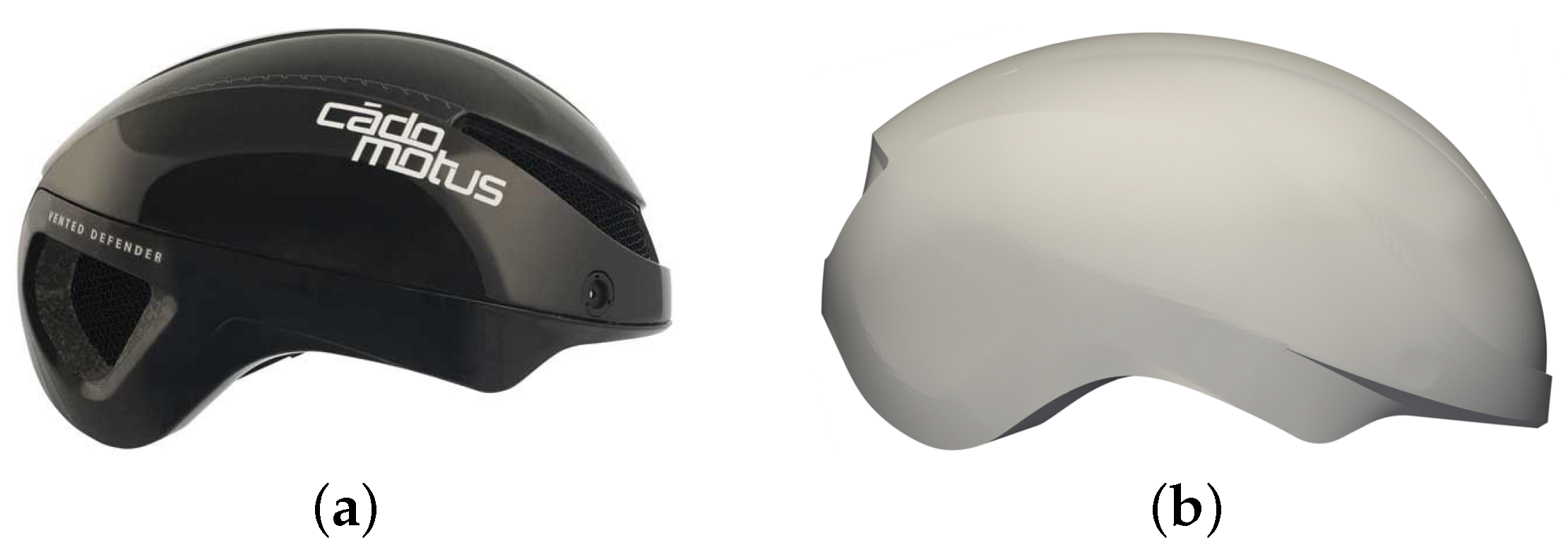
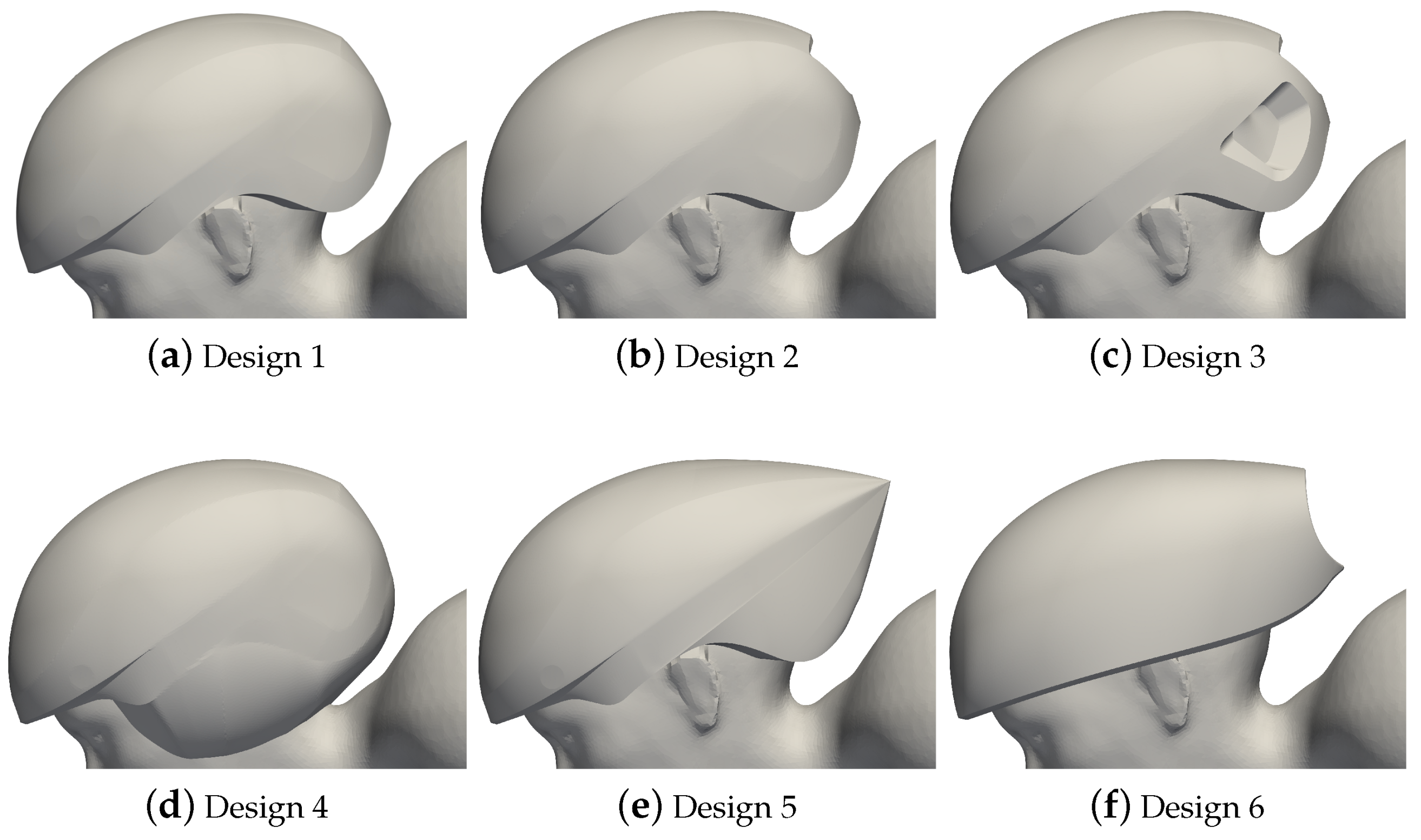

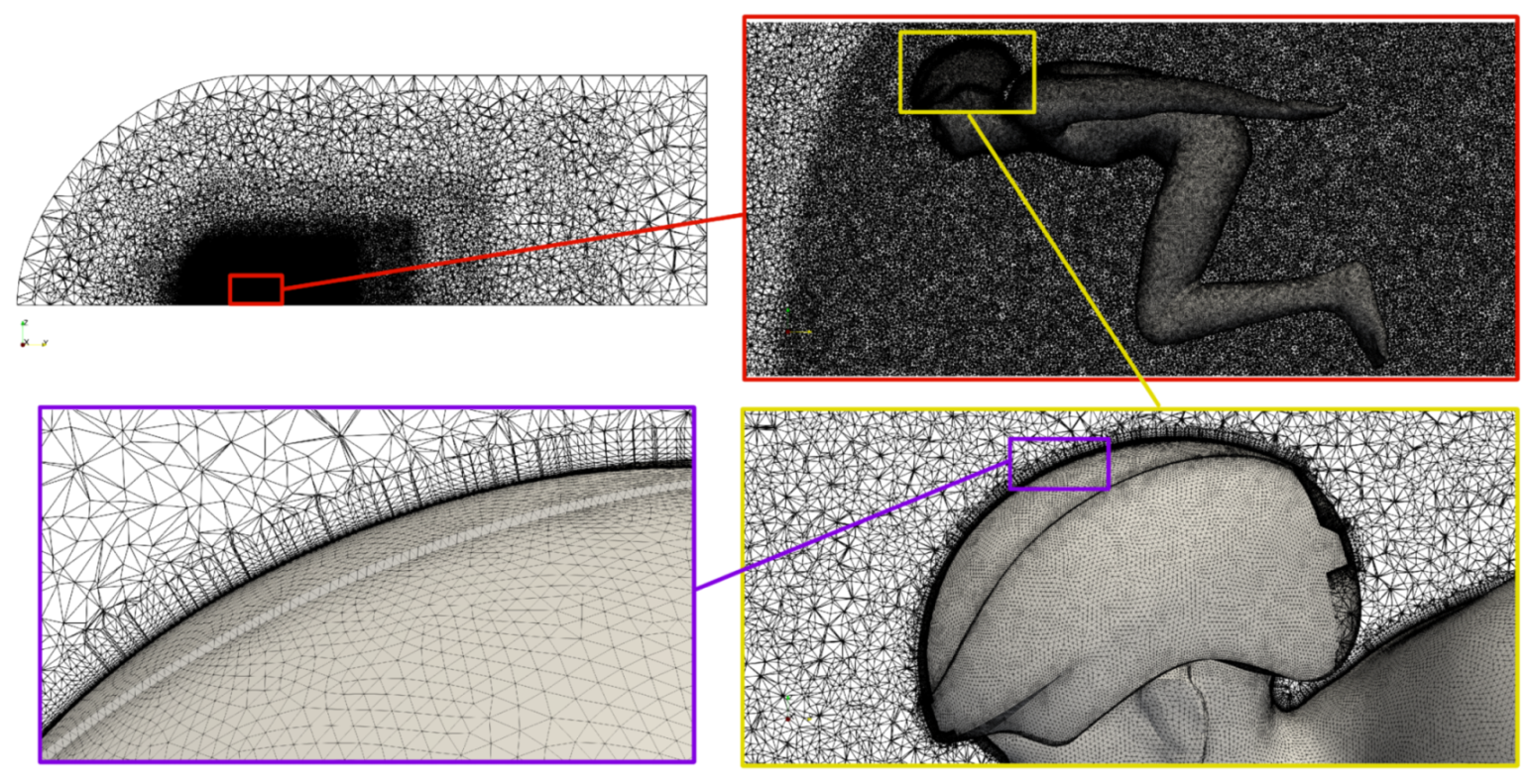
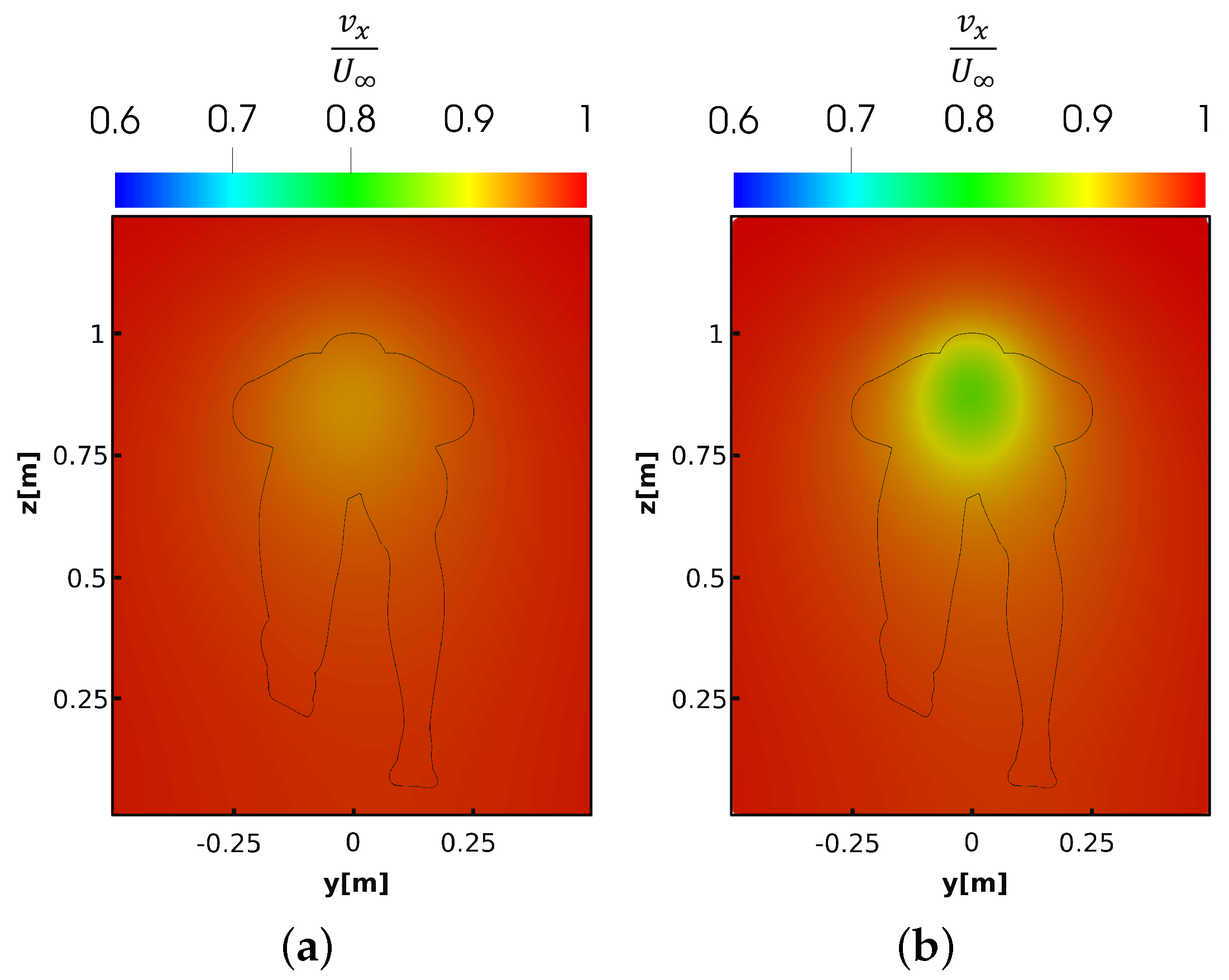
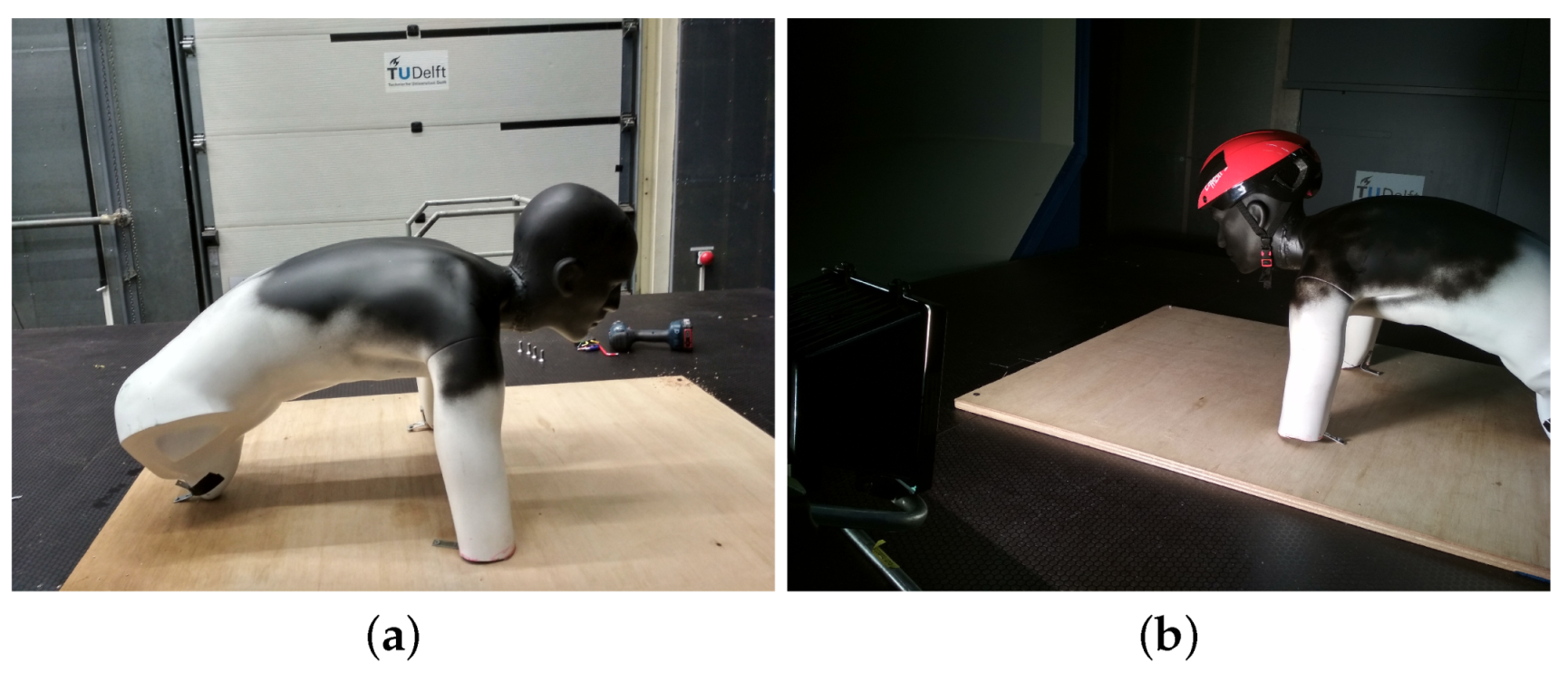
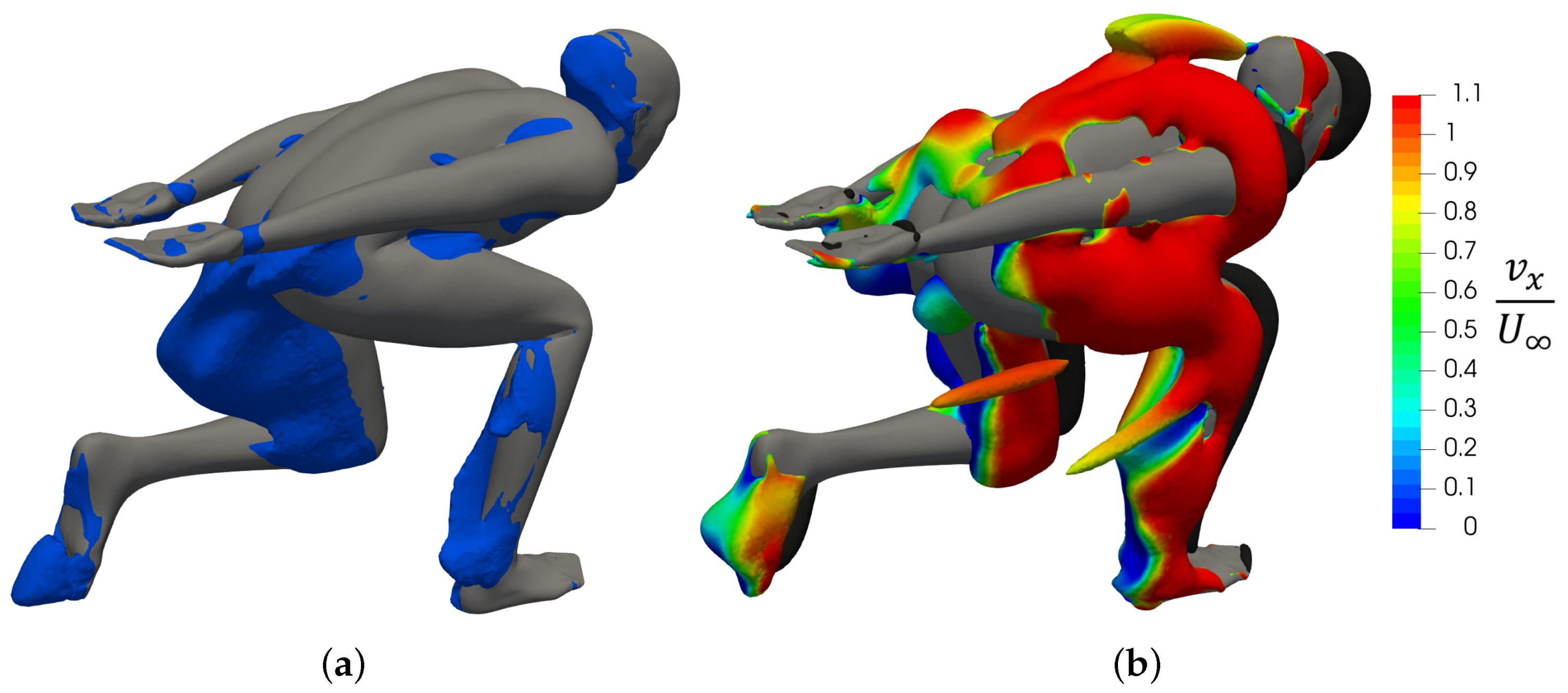
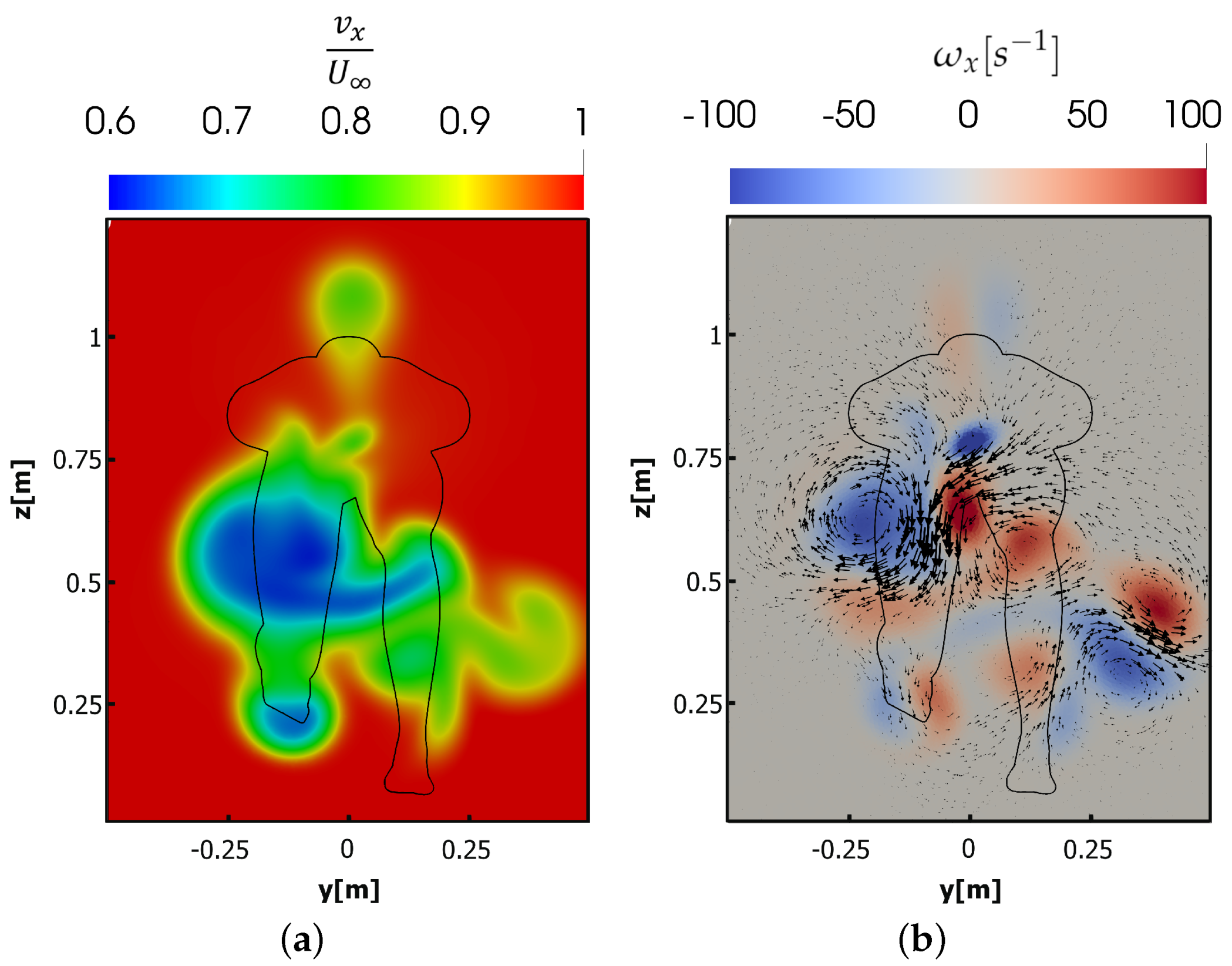
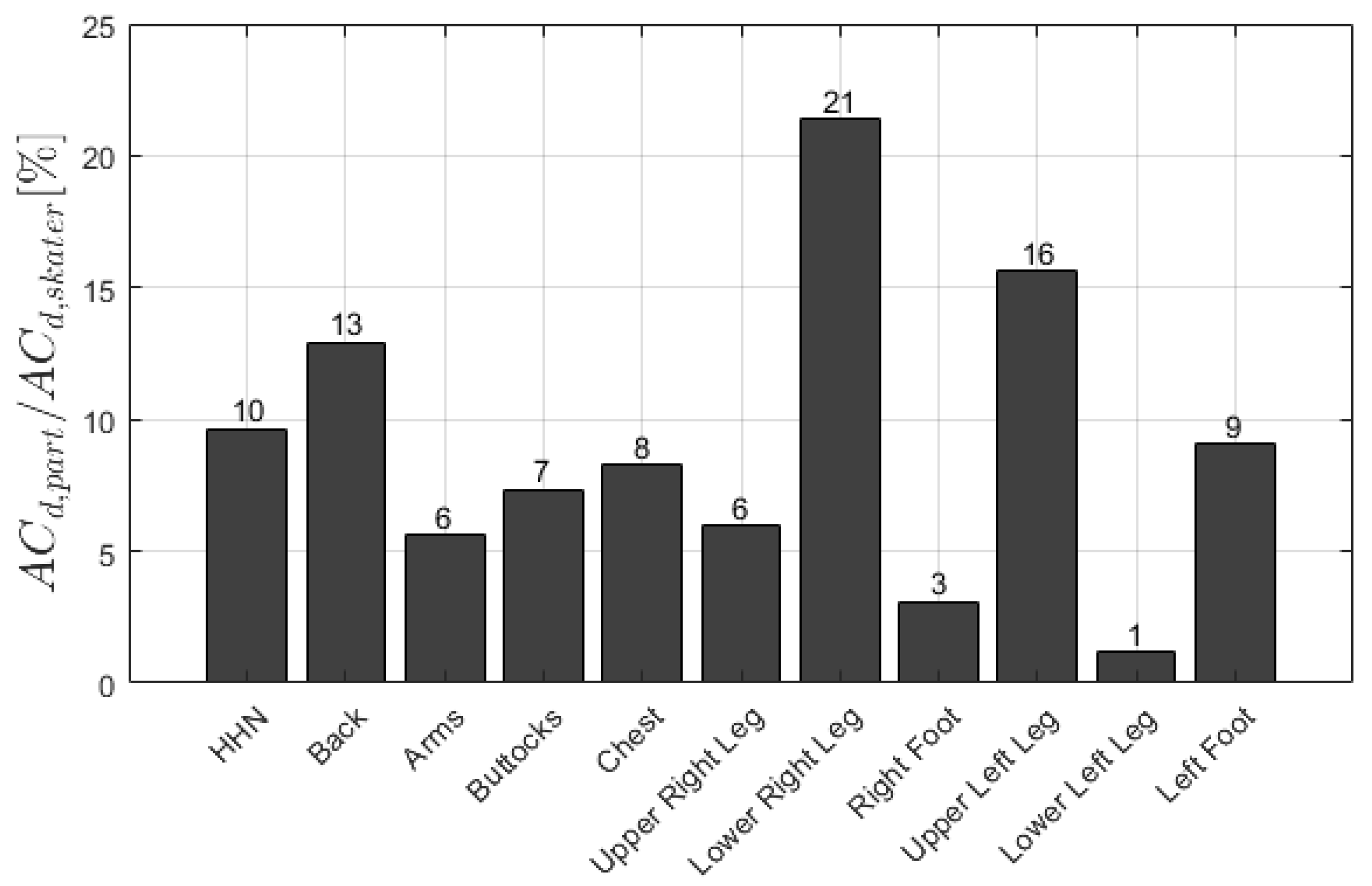
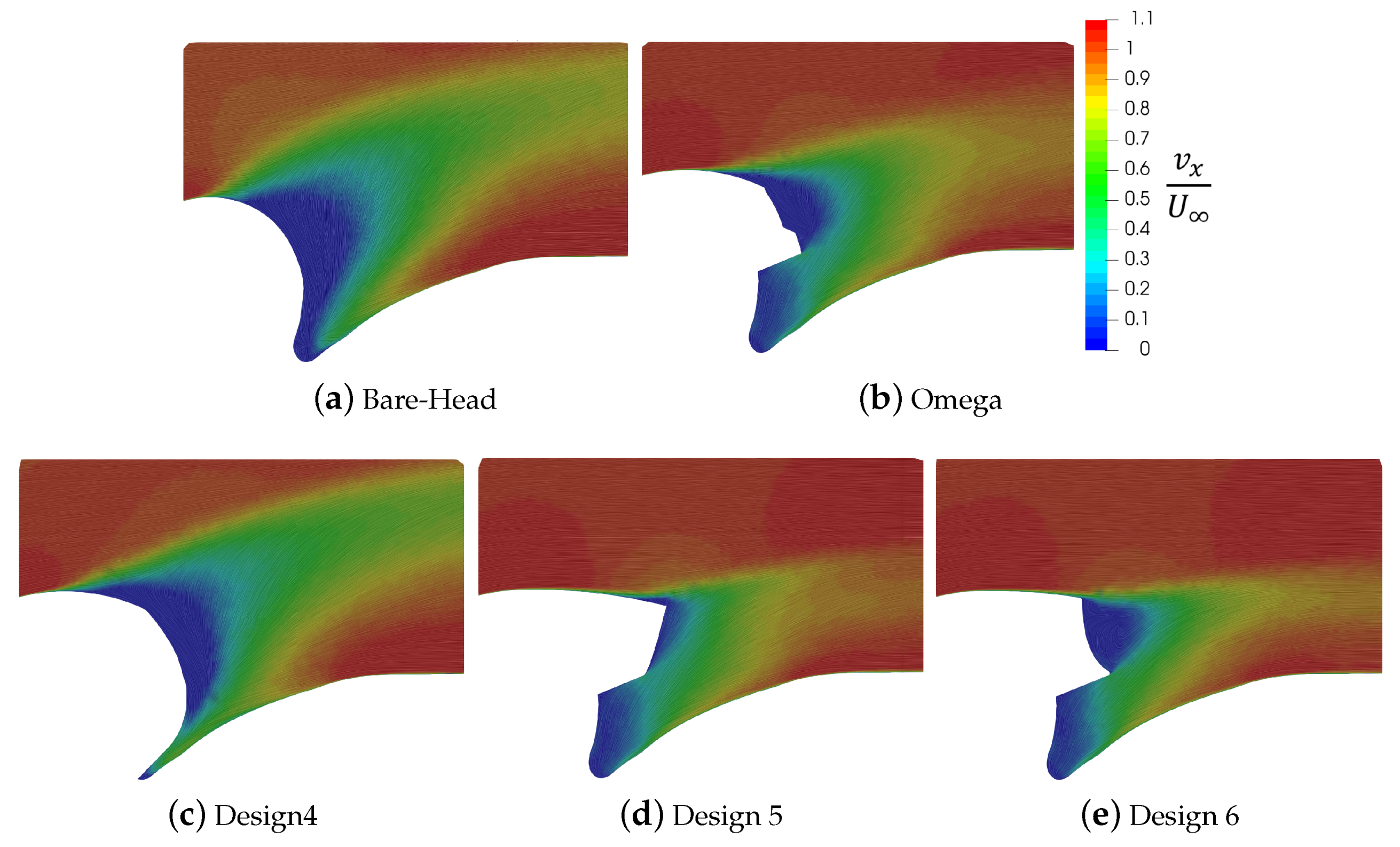
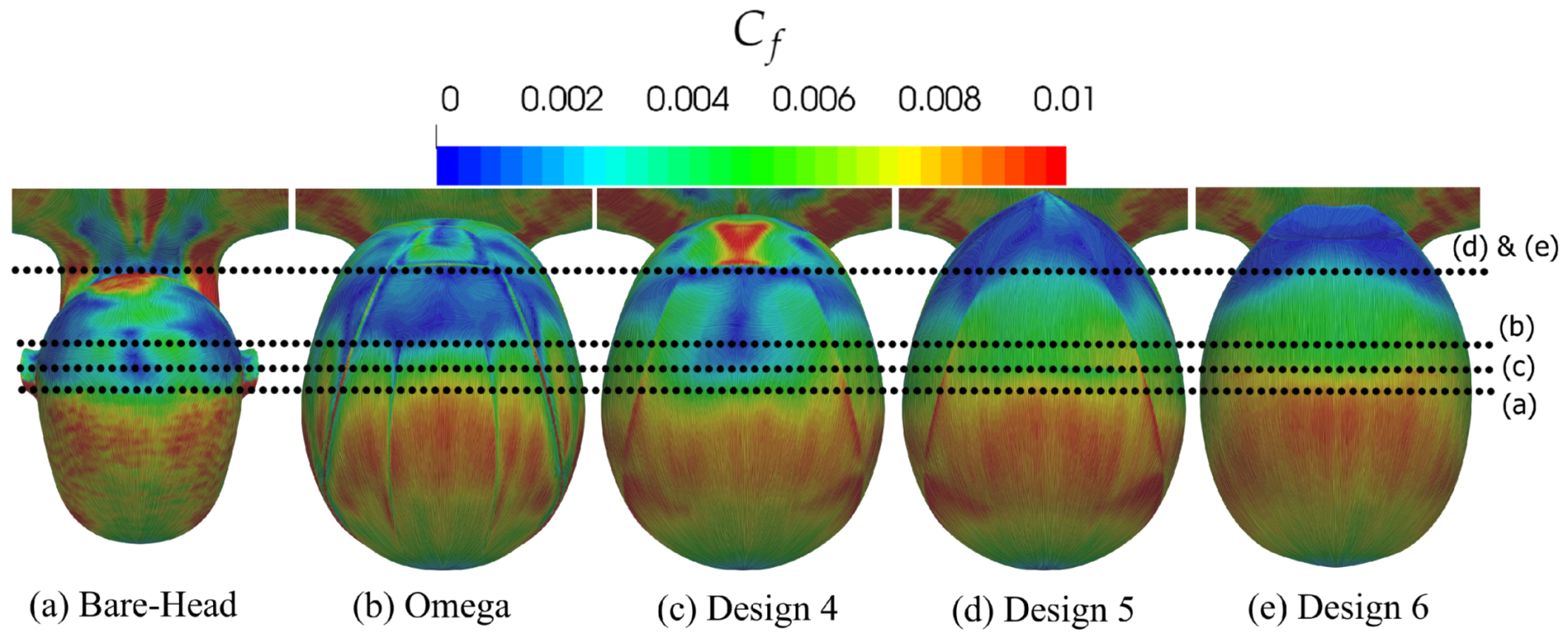
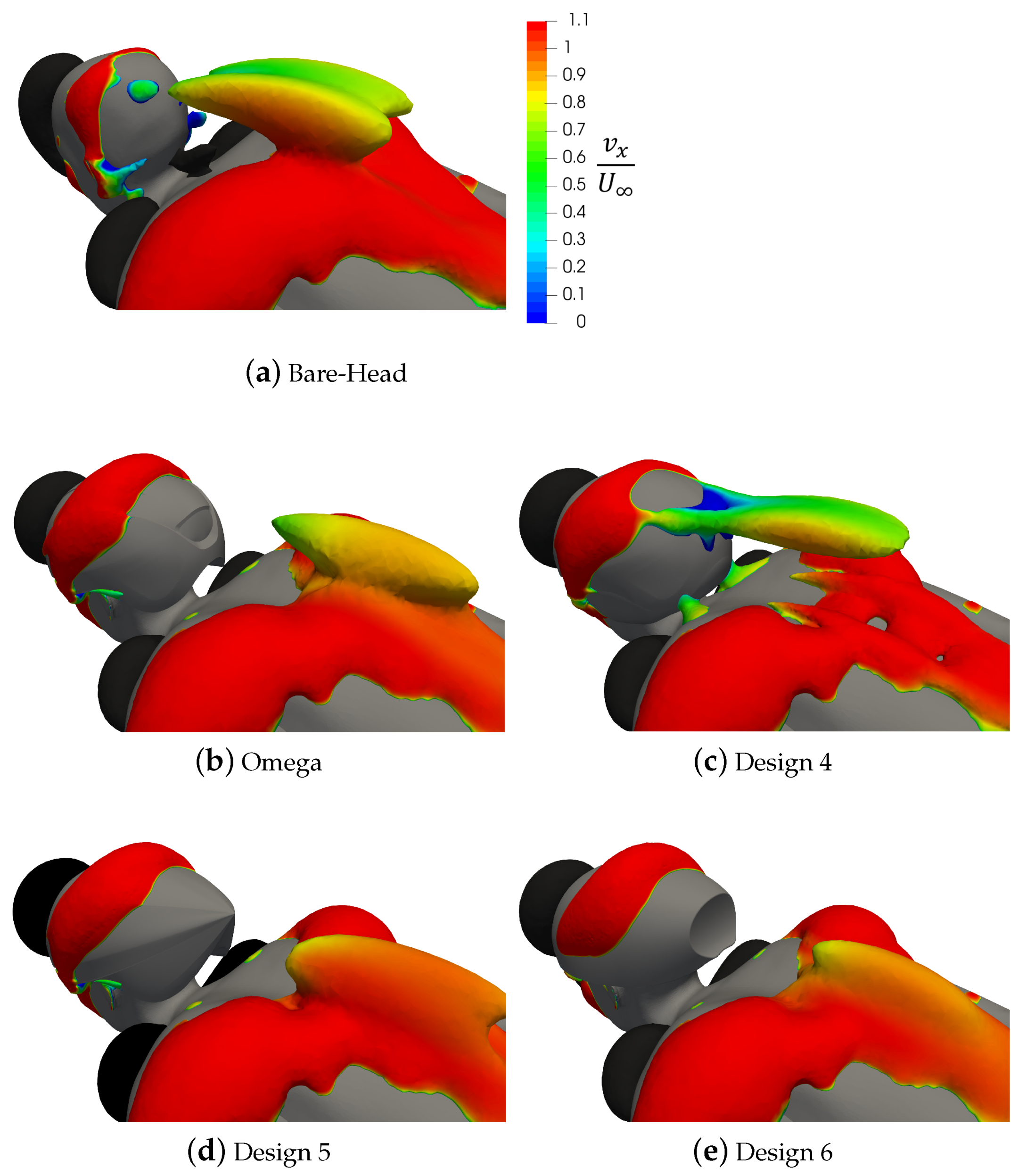

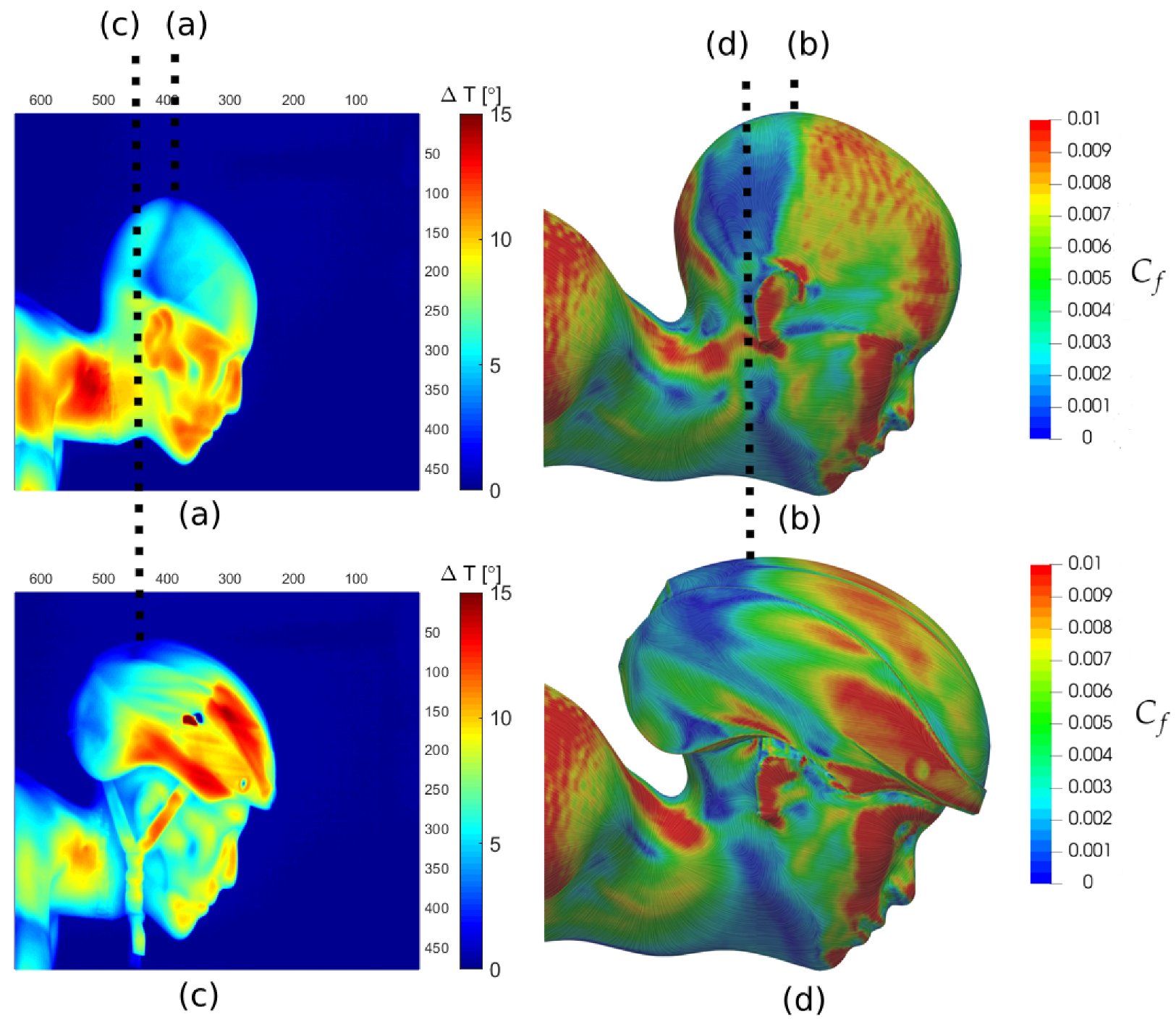
| Case | |||||
|---|---|---|---|---|---|
| Bare-Head | 0.529 ± 0.002 | 0.505 | 0.024 | 95.4 | 4.6 |
| Helmet | |||||
|---|---|---|---|---|---|
| Bare Head | 0.24949 | 0.529 ± 0.002 | 0.13198 | - | - |
| Omega | 0.25398 | 0.506 ± 0.002 | 0.12851 | −4.3 | −2.6 |
| Design 1 | 0.25406 | 0.506 ± 0.002 | 0.12855 | −4.3 | −2.6 |
| Design 2 | 0.25406 | 0.504 ± 0.002 | 0.12804 | −4.7 | −2.9 |
| Design 3 | 0.25406 | 0.506 ± 0.002 | 0.12855 | −4.4 | −2.6 |
| Design 4 | 0.25406 | 0.519 ± 0.002 | 0.13185 | −1.8 | −0.1 |
| Design 5 | 0.25411 | 0.499 ± 0.002 | 0.12680 | −5.7 | −3.9 |
| Design 6 | 0.25410 | 0.498 ± 0.002 | 0.12654 | −5.9 | −4.1 |
| Helmet | ||
|---|---|---|
| Bare Head | 1:40.17 | - |
| Omega | 1:39.34 | −0.83 |
| Design 1 | 1:39.35 | −0.82 |
| Design 2 | 1:39.23 | −0.94 |
| Design 3 | 1:39.35 | −0.82 |
| Design 4 | 1:40.14 | −0.03 |
| Design 5 | 1:38.93 | −1.24 |
| Design 6 | 1:38.86 | −1.30 |
Publisher’s Note: MDPI stays neutral with regard to jurisdictional claims in published maps and institutional affiliations. |
© 2021 by the authors. Licensee MDPI, Basel, Switzerland. This article is an open access article distributed under the terms and conditions of the Creative Commons Attribution (CC BY) license (https://creativecommons.org/licenses/by/4.0/).
Share and Cite
Puelles Magán, G.; Terra, W.; Sciacchitano, A. Aerodynamics Analysis of Speed Skating Helmets: Investigation by CFD Simulations. Appl. Sci. 2021, 11, 3148. https://doi.org/10.3390/app11073148
Puelles Magán G, Terra W, Sciacchitano A. Aerodynamics Analysis of Speed Skating Helmets: Investigation by CFD Simulations. Applied Sciences. 2021; 11(7):3148. https://doi.org/10.3390/app11073148
Chicago/Turabian StylePuelles Magán, Guillermo, Wouter Terra, and Andrea Sciacchitano. 2021. "Aerodynamics Analysis of Speed Skating Helmets: Investigation by CFD Simulations" Applied Sciences 11, no. 7: 3148. https://doi.org/10.3390/app11073148
APA StylePuelles Magán, G., Terra, W., & Sciacchitano, A. (2021). Aerodynamics Analysis of Speed Skating Helmets: Investigation by CFD Simulations. Applied Sciences, 11(7), 3148. https://doi.org/10.3390/app11073148







